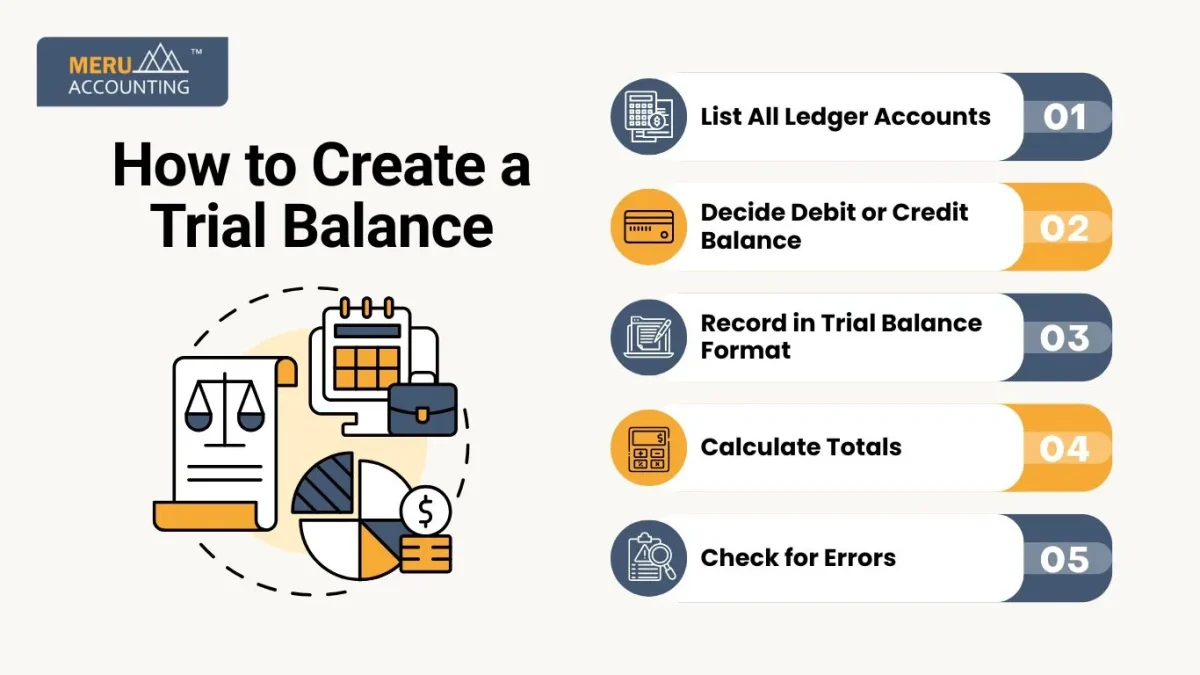How to Create a Trial Balance and Analyze Financial Accuracy in Accounting
Trial Balances are tools that show if accounts are correct. They help check whether all debit and credit totals match. Learning how to create a trial balance helps keep books correct. Every business, accountant, or student needs this skill. Trial balances save time and make errors easy to spot.
They also show a clear view of money in the business. If debit and credit totals match, accounts are correct. If not, mistakes can be found and fixed. Trial Balances are simple but very strong tools. They help owners make good decisions and track money well.
What is a Trial Balance?
- A Trial Balance lists all ledger accounts with their balances.
- It shows each account’s debit or credit at a certain date.
- This report helps find errors before making financial statements.
- Trial Balances make accounting simple and clear for all users.
- They give a solid check to keep books free from mistakes.
Importance of Trial Balances
- Trial Balances help spot mistakes in ledger accounts quickly.
- They make preparing reports like income statements much easier.
- Auditors check trial balances to confirm account accuracy.
- Trial Balances give clear and neat books for all business users.
- Using trial balances saves time and avoids errors in records.
How to Create a Trial Balance
1. List All Ledger Accounts
- Open the ledger and write all accounts with balances.
- Include all accounts: assets, debts, income, and expenses.
- Do not skip accounts with zero balances in the list.
- Listing all accounts ensures totals will be correct at the end.
2. Decide Debit or Credit Balance
- Check if each account has a debit or credit balance.
- Assets and expenses usually have debit; income is credit.
- Debts and owner’s capital are mostly credit balances in books.
- Correct placement keeps totals right and avoids errors later.
3. Record in Trial Balance Format
- Make a table with three columns: Account, Debit, Credit.
- Place balances under the correct columns based on the ledger.
- Every account should appear only once to avoid mistakes.
- Proper tables help read trial balances fast and easily.

4. Calculate Totals
- Add all debit balances to get the total debit figure.
- Add all credit balances to get the total credit figure.
- Compare totals to see if they match exactly.
- Matching totals show accounts are mostly correct and safe.
5. Check for Errors
- If totals do not match, find errors right away.
- Look for missing entries or posting on the wrong side.
- Check all balances carefully to find and fix mistakes.
- Fixing errors ensures final reports are accurate and useful.
Common Errors Found in Trial Balances
- Transposition Error: Writing 540 instead of 450 causes a mismatch.
- Omission: Forgetting a transaction can make the totals wrong.
- Double Posting: Recording one transaction two times inflates totals.
- Misclassification: Posting debit as credit or vice versa causes errors.
- Calculation Mistakes: Wrong addition breaks the debit and credit balance.
- Careful checking of each step lowers the risk of mistakes in accounts.
Types of Trial Balances
- Unadjusted Trial Balance: Done before posting adjusting entries.
- Adjusted Trial Balance: Done after adjusting entries like prepaid items.
- Post-Closing Trial Balance: Done after closing temporary accounts at period end.
- Each type shows accounts are correct at different stages.
- Understanding types makes accounting work simpler and reliable.
Tips for Creating Accurate Trial Balances
- Record transactions each day to reduce missing entries.
- Use simple accounting software for quick and correct totals.
- Check each account balance twice before entering in trial balance.
- Keep personal and business accounts separate for clarity.
- Reconcile with bank statements to verify ledger accuracy.
- These tips help produce error-free and reliable financial reports.
Analyzing Financial Accuracy Using Trial Balances
- Compare current trial balance with past reports to see trends.
- Look for accounts with very high or low balances.
- Check expenses and income patterns for unusual changes.
- Investigate problems quickly to keep books accurate at all times.
- Use trial balances to prepare final financial statements with confidence.
Benefits of Using Trial Balances
1. Prevent Ledger Errors
Trial balances help find errors in accounts fast, keeping records correct.
2. Ease Financial Reporting
They make it easy to prepare income statements and balance sheets. Reports stay clear and true.
3. Boost Audit Speed
Audits are faster when trial balances are full and correct, cutting review time.
4. Support Smart Decisions
Correct account info lets owners and managers make wise financial choices.
5. Keep Records Organized
Trial balances help keep books neat and structured, aiding long-term financial control.
How Accounting Software Helps
- Software automatically adds balances and reduces human mistakes.
- It creates trial balances fast for easier accounting work.
- Alerts help find errors before they affect totals in accounts.
- Software ensures totals are correct and ledgers are well organized.
- Using software makes how to create a trial balance much easier.
Example of a Simple Trial Balance
Account Name | Debit ($) | Credit ($) |
Cash | 5,000 | |
Accounts Receivable | 2,500 | |
Equipment | 8,000 | |
Accounts Payable | 3,000 | |
Capital | 12,500 |
- Total Debit = $15,500 and Total Credit = $15,500.
- Balanced totals show accounts are recorded correctly.
- This simple example can grow for bigger businesses easily.
- Checking totals often keeps accounts always accurate and safe.
Steps After Preparing the Trial Balance
1. Adjust Entries
Fix prepayments, accruals, and depreciation to keep accounts right. This makes sure all costs and income are in the correct period. Good adjustments make reports clear and correct.
2. Prepare Financial Reports
Use the trial balance to make income statements and balance sheets. These show the true state of the business. Clear reports help owners see finances fast.
3. Resolve Discrepancies
Check for errors and correct them before final reports. Fixing mistakes early stops bigger issues later. It also makes reports more reliable.
4. Verify Before Final Reports
Check the trial balance to confirm all numbers are right. This final review helps catch missing entries. It cuts the risk of mistakes in reports.
5. Keep Accuracy Over Time
Use trial balances often to keep books correct long-term. It also makes reporting consistent and audits easier. Regular checks build trust in the data.
Common Mistakes While Creating Trial Balances
- Ignoring small transactions may cause totals to be wrong.
- Posting to the wrong column can break debit and credit balance.
- Skipping zero balance accounts reduces accuracy and completeness.
- Forgetting adjustments like prepaid items misstates totals in accounts.
- Not updating ledger balances regularly leads to calculation errors.
- Careful checking avoids mistakes and keeps books reliable all time.
Differences Between Trial Balance and Balance Sheet
Feature | Trial Balance | Balance Sheet |
Purpose | Shows all ledger balances for checking errors | Shows financial position: assets, liabilities, equity |
Use | Internal tool for accountants | External report for stakeholders |
Nature | Not a formal financial statement | Formal financial statement |
Preparation | Prepared periodically to detect errors | Prepared at the end of an accounting period |
Content | Includes all debit and credit balances | Includes assets, liabilities, and equity |
Audience | Used by accountants and internal staff | Used by investors, creditors, and management |
Function in Decision-Making | Helps ensure accuracy in records | Helps stakeholders make financial decisions |
The Role of Trial Balances in Auditing
1. Quick Check of Ledger
Auditors use trial balances to check ledgers quickly. This shows if all entries are right before a full audit.
2. Matching Debits and Credits
Trial balances show if debits and credits match. When they match, accounts are less likely to have mistakes.
3. Spotting Errors Early
Mistakes in trial balances point to bigger issues. Auditors can fix them before they grow.
4. Saving Audit Time
Trial balances save time in audits. Auditors can look at problem areas, not each entry.
5. Stronger Audit Trust
Correct trial balances make audits more secure. They give a base for reports and cut errors.
6. Quick Financial Review
Trial balances help check a firm’s health quickly. They show trends or unusual entries to watch.
7. Easy Compliance Checks
Trial balances help check rules and laws. They show accounts that may need a fix.
How Trial Balances Help With Tax Filing
1. Show Correct Income and Costs
Trial balances give the right income and cost numbers. This helps keep tax info true.
2. Make Tax Filing Fast
Trial balances make filing taxes quick. Less time is spent fixing mistakes.
3. Find Mistakes Early
Errors in trial balances can lead to wrong tax numbers. Spotting them early stops problems.
4. Ensure Rule Compliance
Using trial balances helps meet tax rules. Accounts match what the law asks.
Learning how to create a trial balance is key for correct accounting. Trial Balances track money, find mistakes, and make reports reliable. They help owners make smart choices with correct data. Using trial balances saves time, reduces mistakes, and keeps books neat.
Meru Accounting helps businesses with correct trial balances and reports. Their experts check all accounts, fix errors, and guide clients step by step. We use software to make totals correct and fast. Businesses can trust Meru Accounting for clean records. Our service makes accounting easy and accurate for every business.
FAQs
Q1. What is a trial balance?
It is a list of all account balances at a certain date.
Q2. Why is a trial balance important?
It helps find mistakes and ensures accounts are correct.
Q3. How often should I prepare a trial balance?
At the end of each month or accounting period.
Q4. Can trial balances detect all errors?
No, some errors may remain hidden if posted incorrectly.
Q5. What are the main types of trial balances?
Unadjusted, adjusted, and post-closing trial balances are used differently.
Q6. How does software help in trial balances?
It adds balance automatically and reduces human errors quickly.
Q7. What to do if the trial balance does not match?
Check ledger entries and columns carefully to find the errors.








